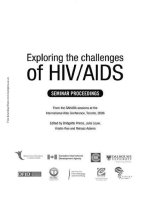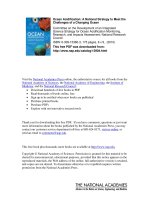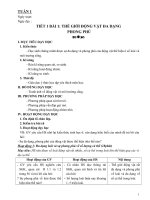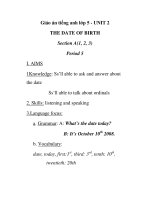- Trang chủ >>
- Mầm non - Tiểu học >>
- Lớp 5
5 1 2 the challenges of storm chasing TG
Bạn đang xem bản rút gọn của tài liệu. Xem và tải ngay bản đầy đủ của tài liệu tại đây (118.03 KB, 4 trang )
The Challenges of
Storm Chasing
SUMMARY
In Tornado Alley, which crosses the
plains of the United States, storm chasers
track tornadoes to learn more about them
and to experience the thrill of seeing them up
close. But storm chasing can be dangerous,
especially when practiced by novice chasers.
LESSON VOCABULARY
branded
daintily
lullaby
resourceful
veins
constructed
devastation
pitch
thieving
INTRODUCE THE BOOK
INTRODUCE THE TITLE AND AUTHOR
5.1.2
CAUSE AND EFFECT
MONITOR AND FIX UP
READ THE BOOK
SET PURPOSE
Ask students to set a purpose
for reading The Challenges of Storm Chasing.
Ideas might include to learn about the tools
of storm chasers, to learn how storm chasers
find tornadoes, and to understand the
dangers of storm chasing.
STRATEGY SUPPORT: MONITOR AND FIX UP
Have
students take notes as they read and then
prepare an outline of The Challenges of Storm
Chasing. Remind students that an outline can
help them better understand how a piece of
writing is organized and can serve as a way
of summarizing text.
COMPREHENSION QUESTIONS
Discuss
with students the title and the author of The
Challenges of Storm Chasing. Have students
discuss the challenges they expect to read
about.
PAGE 5 What are some of the goals of a
storm chaser? (to study weather patterns and
meteorology and to experience the thrill of
seeing a tornado up close)
BUILD BACKGROUND
PAGE 7
Ask students whether they
have ever seen a tornado in real life, on TV,
or in a movie. Ask them to describe what they
have seen. Ask: What other types of storms
have you seen up close?
Students may come from countries
that do not have tornadoes. Show students
photographs of tornadoes to help them
visualize this type of storm. Encourage
them to describe a tornado and the kinds
of damage it can do.
PREVIEW/USE TEXT FEATURES
Have students
preview the book by looking at the photographs,
the map on pages 4–5, and the diagrams on
pages 10 and 13. Ask: What do you think you
will learn from this book?
16
What are some popular storm-tracking
tools? (radar, laptop computers, video cameras,
radios, satellite images)
PAGE 9
What effect do “renegade” storm
chasers have on others? (They make roads
more dangerous by speeding; they risk their own
lives and the lives of others.)
PAGES 12–13
What makes a tornado funnel?
(Cold air moves over warm air. Then lighter air
rises up through cold air, creating the funnel
cloud, which rotates.)
PAGE 15 What were the effects of the May
1999 Oklahoma tornado? (It destroyed houses
and neighborhoods around Oklahoma City.)
PAGE 19 How and when did storm chasing
begin? (In the 1950s, a North Dakota man
followed storms and photographed them.)
The Challenges of Storm Chasing
16917_LRD_TG_016-017 16
12/28/05 12:57:48 PM
REVISIT THE BOOK
READER RESPONSE
1. Tornado Alley has many storms in the spring
because of weather patterns that occur
during that time of year. This makes spring
the best season to spot tornadoes, but a
dangerous time as well.
2. Responses will vary. Learned: NSSL was set
up to track storms and inform citizens;
scientists study storms and improve forecasting by using “Doppler on Wheels” and
other equipment. Want to Know: the
devastation of tornadoes, their frequency,
and safety precautions to take.
3. brand, construct; sentences will vary.
4. Responses will vary. Students should know
which states are part of Tornado Alley and
where it is located in the U.S.
EXTEND UNDERSTANDING
Encourage students
to discuss why the photographs and diagrams
are such an integral part of the book. Ask:
Without the photos, would you have enjoyed
this book as much? What did the photos and
diagrams help you learn?
RESPONSE OPTIONS
WRITING
Have students prepare a list of things
they would do or not do in order to remain
safe during a tornado.
SCIENCE CONNECTION
Have students research
Hurricane Hunters, people
who fly into the eye of a
hurricane to study it. Invite
students to go to the library or use
the Internet for their research.
Skill Work
TEACH/REVIEW VOCABULARY
After you review the meanings of the
vocabulary words with students, call on
volunteers to use each word in a sentence.
TARGET SKILL AND STRATEGY
CAUSE AND EFFECT Remind students
that a cause is why something happened;
the effect is what happened. Note that
sometimes a cause may have multiple
effects, and an effect may have more than
one cause. Encourage students to pose
questions to themselves as they read, such
as: What happened? What caused it to
happen? This will work especially well when
students read about tornadoes and look at
photos on pages 14–15.
MONITOR AND FIX UP Note that there
are likely to be new words and challenging
concepts in the text, so students will
want to adopt strategies to monitor
comprehension as they read. Encourage
them to use fix-up strategies: summarizing
facts to clarify ideas (perhaps on paper);
slowing their reading rate; using diagrams,
maps and photos. Explain that they can
use graphic sources such as the diagram
on page 13 to help them understand how a
tornado (effect) is caused.
ADDITIONAL SKILL INSTRUCTION
DRAW CONCLUSIONS
Remind students that
a conclusion is a sensible decision reached
after you have thought about details or facts
you have read. Drawing conclusions is the
process of making those sensible decisions.
After students have finished reading the
text, looking at the photos, and studying
the diagrams, have them draw conclusions
about the dangers of tornadoes.
The Challenges of Storm Chasing
16917_LRD_TG_016-017 17
17
12/28/05 12:57:49 PM
Storm Chasing
Name
Cause and Effect
• A cause is the reason something happens. The effect is what happens.
• A cause may have more than one effect, and an effect may have more than one cause.
• Sometimes a cause is not directly stated, and you need to think about why something
happened.
Directions Read the following passage. Then answer the questions that follow.
Tornadoes form when a layer of cold air moves over a layer of warm air. The lighter air rises
up through the cold air. This makes the funnel cloud rotate as the air changes places. A tornado
can do amazing damage to buildings, property, and land. Tornado winds, rising to a furious
pitch, will rip through a town, and destroy everything in their path. Houses and mobile homes
may be flattened, ripped apart, or carried away completely. A tornado can even peel the bark
off trees!
But as dangerous as they are, tornadoes are a great source of delight for storm chasers. They
love to seek out, or chase, tornadoes. Their task is a dangerous one. High winds can flip the
chaser’s vehicle or blow out car windows. Heavy rain and hail can make it hard to see. Flooding
and fog can make traveling harder and might strand a chaser in the path of a storm. Lightning,
a release of electricity in the atmosphere, is another danger for storm chasers. It can strike
without warning!
1. Describe the cause of tornadoes.
2. What are two effects of tornadoes?
4. What are two effects of tornadoes on storm chasers?
© Pearson Education 5
3. What is the cause for lightning, as stated in the passage?
5. Would you like to be a storm chaser? Why or why not? Give examples from the reader to
support your choice.
18
16917_LRD_TG_018_019 1
12/28/05 12:58:11 PM
Storm Chasing
Name
Vocabulary
Directions Write the vocabulary word that best matches each definition below. One word, with two
different meanings, is used twice.
Check the Words You Know
branded
devastation
resourceful
constructed
lullaby
thieving
daintily
pitch
veins
1. the act of laying waste, destroying
2. likely to steal
3. with delicate beauty
4. thick, black, sticky substance made from tar
5. natural channels through which water flows
6. soft song sung to put a baby to sleep
7. good at thinking of ways to do things
8. marked by burning
9. tubes that carry blood through your body
10. put together
Directions Choose two vocabulary words and use each in a sentence below.
© Pearson Education 5
11.
12.
19
16917_LRD_TG_018_019 2
12/28/05 12:58:13 PM









